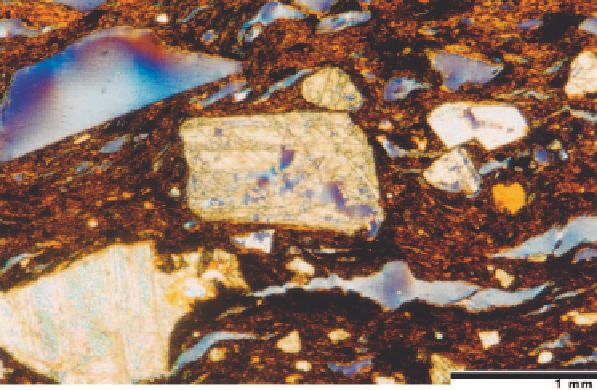Geology Reference
In-Depth Information
Fig. 19.5.
Thin section of an Auerberg pot
sherd. The brown clay matrix shows par-
allel blueish shrinkage pores. The pores as
well as some temper grains (left upper cor-
ner) are open indicating 'lime blowing'.
The marble temper grains (center and left
bottom corner) have partially lost their fab-
ric due to the burning process. The altered
marble grains exhibit a skeletal structure
that still reflects more or less the original
twin and cleavage lamellae.
Frequency can be measured by (a) the number of grains
within a defined area, usually one square millimeter,
(b) the number of grains along transect lines of 10 cm
length, and (c) the percentage of grain size fractions
(<0.1, 0.1-0.5 and >0.5 mm). Maximum grain size is
another often used measure. Riederer (1985) proposed
a semiquantitative classification of ceramic fabric types
based on increasing grain size and an increasing num-
ber of temper grains per sq.mm. These data may re-
flect differences in provenance but also different pro-
duction techniques. Point-, line-, ribbon- and area-
counting are applied to ceramics (Middleton et al. 1985;
see Sect. 6.2).
• The
microfacies
of small carbonate grains occurring
as inclusions in coarse ceramics provide important clues
to the provenance of the raw material (Pl. 151/6-7).
Carbonate rock fragments and fossils (e.g. foraminifera,
mollusk shells) occurring as isolated skeletal grains
within the matrix or enclosed within rock fragments
are of prime importance. The dating of fossils and oc-
currence of specific microfacies types in combination
with the regional geology data facilitate the location of
potential source areas of the raw material. This assists
in distinguishing between locally produced and im-
ported pottery.
The combination of petrographic and microfacies
characteristics of carbonate temper grains with carbon
and oxygen isotope data is a highly successful tool for
answering archaeological questions, as shown by the
following example.
described from the Auerberg near Bernbeuren in south-
ern Bavaria, this type has been found between Kempten
in Bavaria and Carnuntum near Vienna in Austria and
between the Danube and South Tyrol and Friuli in north-
ern Italy. Archaeological analyses proved that the coarse
ware named 'Auerberg pots' (Fig. 19.4) includes im-
ported material as well as local production. Both prod-
ucts exhibit a conspicuous tempering by white marble
grains (Pl. 151/7).
The addition of marble and limestone as temper
grains facilitates the plasticity and workability of clay,
influences shrinkage processes during drying and after
burning, improves porosity development during burn-
ing, and increases resistance to thermic shocks (Gibson
and Woods 1990; Santoro et al. 1988)
The marble inclusions were studied by means of thin
sections (Fig. 19.5) and stable isotopes of the temper
grains. The composition of the ceramic matrix was in-
vestigated using neutron activation analysis and Möss-
bauer spectroscopy. The latter methods indicate dis-
tinct differences between local and imported Auerberg
pots (Ch. Flügel et al. 2000).
The isotope analyses of the marble temper grains
(Ch. Flügel et al. 1997) resulted in the recognition of
different δ
13
C/δ
18
O patterns for samples from differ-
ent areas. Isotope patterns of black Auerberg pot sherds
found in southern Germany agree with patterns of
marbles occurring in South Tyrol. Thin sections of these
marbles show differences in crystal fabric, crystal size
and accessory minerals, which point to the addition of
a specific marble type (Sterzing marble) to the clay
used for the production of the pots. Most probably the
fine temper grains (average size between 0.5 and
1.5 mm) represent off-cuts of the production of marble
building stones located near Lienz/Aguntum in east-
ern Tyrol, Austria (Ch. Flügel et al. 2004).
19.5.2 Ceramics: Example
A specific black coarse pottery typified by a triangular
rim profile was in use in several Roman provinces (Ch.
Flügel 1999) during the first century AD. Originally

